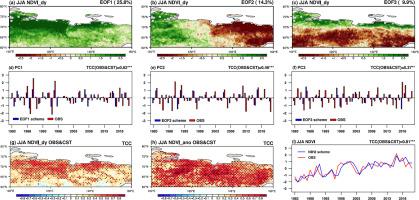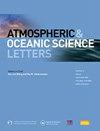Principal modes of summer NDVI in eastern Siberia and its climate prediction schemes
IF 3.2
4区 地球科学
Q3 METEOROLOGY & ATMOSPHERIC SCIENCES
引用次数: 0
Abstract
Based on a normalized difference vegetation index (NDVI) dataset for 1982–2021, this work investigates the principal modes of interannual variability in summer NDVI over eastern Siberia using the year-to-year increment method and empirical orthogonal function (EOF) analysis. The first three principal modes (EOF1–3) of the year-to-year increment of summer NDVI (NDVI_DY) exhibit a regionally consistent mode, a western–eastern dipole mode, and a northern–southern dipole mode, respectively. Further analysis shows that sea surface temperature (SST) in the tropical Indian Ocean in February–March and western Siberian soil moisture in April could influence EOF1. EOF2 is modulated by April Northwest Pacific SST and western Siberian soil moisture in May. May North Atlantic SST and sea ice in the Kara Sea in the preceding October significantly affect EOF3. Using the year-to-year increment method and multiple linear regression analysis, prediction schemes for EOF1–3 are developed based on these predictors. To assess the predictive skill of these schemes, one-year-out cross-validation and independent hindcast methods are employed. The temporal correlation coefficients between observed EOF1–3 and the cross-validation results are 0.62, 0.46, and 0.37, respectively, exceeding the 95 % confidence level. In addition, reconstructed schemes for summer NDVI are developed using predicted NDVI_DY and the observed principal modes of NDVI_DY. Independent hindcasts of NDVI anomalies during 2019–2021 also present consistent distributions with the observed results.
摘要
本文基于1982–2021年的归一化植被指数 (Normalized Difference Vegetation Index, NDVI) 数据集, 利用年际增量法和经验正交函数方法提取了夏季东西伯利亚地区NDVI的年际变化主模态. NDVI年际增量 (NDVI_DY) 的前3个主模态 (EOF1–3) 分别呈全区一致, 东西偶极子和南北偶极子变化特征. 进一步分析影响其主模态变化的影响因子显示, 前期2–3月热带印度洋海温和4月西西伯利亚土壤湿度是全区一致模态的关键影响因子, 东西偶极子模态受前期4月西北太平洋海温和5月西西伯利亚土壤湿度的调控, 前期5月北大西洋海温和前一年10月喀拉海海冰与南北偶极子模态相联. 本文利用上述前期关键影响因子, 基于多元线性回归分析和年际增量方法建立了夏季东西伯利亚地区NDVI_DY主模态的预测模型. 其中, 观测的EOF1–3对应的时间序列与各模态交叉检验结果的时间相关系数分别为0.62, 0.46和0.37, 均超过了95 %的置信水平. 此外, 利用预测的各模态对应时间序列和观测的主模态, 本文进一步建立了夏季东西伯利亚地区NDVI的场重建预测模型. 2019–2021年夏季东西伯利亚地区独立后报的NDVI距平的空间分布也与观测一致.

东西伯利亚夏季NDVI的主要模态及其气候预测方案
基于1982—2021年的归一化植被指数(NDVI)数据集,利用年增量法和经验正交函数(EOF)分析研究了东西伯利亚夏季NDVI年际变化的主要模式。夏季NDVI (NDVI_DY)年增量的前3个主模态(EOF1-3)分别表现为区域一致模态、东西偶极子模态和南北偶极子模态。进一步分析表明,2 - 3月热带印度洋海温(SST)和4月西伯利亚西部土壤湿度可能影响EOF1。EOF2受4月西北太平洋海温和5月西伯利亚西部土壤湿度的调制。5月前10月北大西洋海温和喀拉海海冰显著影响EOF3。利用年际增量法和多元线性回归分析,建立了EOF1-3的预测方案。为了评估这些方案的预测能力,采用了一年交叉验证和独立后验方法。观测到的EOF1-3与交叉验证结果的时间相关系数分别为0.62、0.46和0.37,均超过95%的置信水平。利用预测的NDVI_DY和实测的NDVI_DY主模态,提出了夏季NDVI的重建方案。2019-2021年NDVI异常的独立后验也呈现出与观测结果一致的分布。摘要本文基于1982 - 2021年的归一化植被指数(归一化植被指数NDVI)数据集,利用年际增量法和经验正交函数方法提取了夏季东西伯利亚地区NDVI的年际变化主模态。NDVI年际增量(NDVI_DY)的前3个主模态(EOF1-3)分别呈全区一致,东西偶极子和南北偶极子变化特征。进一步分析影响其主模态变化的影响因子显示, 前期2–3月热带印度洋海温和4月西西伯利亚土壤湿度是全区一致模态的关键影响因子, 东西偶极子模态受前期4月西北太平洋海温和5月西西伯利亚土壤湿度的调控, 前期5月北大西洋海温和前一年10月喀拉海海冰与南北偶极子模态相联. 本文利用上述前期关键影响因子,基于多元线性回归分析和年际增量方法建立了夏季东西伯利亚地区NDVI_DY主模态的预测模型。其中,观测的EOF1-3对应的时间序列与各模态交叉检验结果的时间相关系数分别为0.62,0.46和0.37,均超过了95%的置信水平。此外,利用预测的各模态对应时间序列和观测的主模态,本文进一步建立了夏季东西伯利亚地区NDVI的场重建预测模型。2019-2021年中国《金融时报》中国版《金融时报》
本文章由计算机程序翻译,如有差异,请以英文原文为准。
求助全文
约1分钟内获得全文
求助全文
来源期刊

Atmospheric and Oceanic Science Letters
METEOROLOGY & ATMOSPHERIC SCIENCES-
CiteScore
4.20
自引率
8.70%
发文量
925
审稿时长
12 weeks
 求助内容:
求助内容: 应助结果提醒方式:
应助结果提醒方式:


